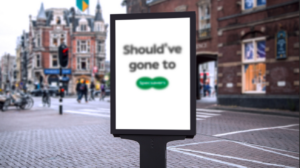JCDecaux and New Digital Age (NDA) have partnered to stage the Programmatic DOOH Live Awards on 24 April 2024 in London. Here, event judge Dom Kozak, Head of Programmatic at JCDecaux, shares his thoughts on the latest developments in out-of-home advertising and, also, describes what he believes would make a strong entry…
How can programmatic digital OOH fit into clients’ existing attribution and effectiveness models?
Programmatic digital out-of-home (pDOOH) advertising can be integrated into existing attribution and effectiveness models through various methods. For example, to measure performance-based KPIs, location-based data can be used to track consumer behaviour and measure the impact of pDOOH campaigns. By analysing mobile device data or GPS signals, advertisers can assess the correlation between exposure to pDOOH ads and actions such as store visits or purchases. From a brand perspective, brand lift studies are a great way to measure the impact of pDOOH on brand awareness, consideration, and purchase intent. By comparing pre- and post-campaign metrics, advertisers can assess the effectiveness of pDOOH in driving key brand metrics and influencing consumer perceptions.
From an attribution perspective, pDOOH can be easily integrated into any multi-touch model to allocate credit to different touchpoints e.g. search, display, social, TV, etc. along the consumer journey. By analysing cross-channel interactions and conversions, advertisers can better understand how pDOOH complements other marketing efforts and contributes to overall campaign performance. By integrating pDOOH advertising into existing attribution and effectiveness models, advertisers can gain actionable insights into the performance of their campaigns and optimize their strategies to achieve their marketing objectives.
What do you see as the primary benefits of programmatic activation in OOH?
Programmatic activation in out-of-home (OOH) advertising offers several benefits. Programmatic technology automates the process of buying and selling OOH ad space, streamlining campaign management and reducing manual effort. Targeting campaigns using location, demographics, time of day, weather conditions, and first-party data insights enables advertisers to deliver tailored messages to specific audiences, increasing relevance and effectiveness. Advertisers can easily scale campaigns up or down based on budget, objectives, and market conditions, with the flexibility to adjust targeting and creative elements as needed. This dynamic creative optimisation enhances the effectiveness of campaigns by delivering more personalised and engaging messages, at scale.
Real-time optimisation drives additional efficiency allowing buyers to dynamically adjust campaign parameters in real-time based on performance data and audience insights. This flexibility allows for optimisation of ad placements, creative messaging, and targeting strategies to maximise campaign effectiveness. From a cross-channel perspective, when programmatic buying means that DOOH can be fully integrated with other digital channels such as mobile, social media, and online advertising to create cohesive cross-channel campaigns. By synchronising messaging and targeting across multiple channels, advertisers can amplify their reach and engagement with consumers.
How will clients and agencies use data for targeting and measurement over the next 2-3 years?
As pDOOH platforms continue to leverage data analytics, we can expect to see advancements in audience targeting capabilities which will vary depending on campaign objectives. This could involve more sophisticated audience segmentation based on factors such as demographics, interests, behaviours, and real-time location data. With increasing emphasis on data privacy and regulations, I think we will see more first-party data integration which will enable more precise audience targeting while maintaining compliance with privacy regulations. I think we will also see a greater focus on contextual targeting in pDOOH, where ads are delivered based on the context of the surrounding environment.
Integration with other digital channels for cross-channel measurement and attribution is going to become more prevalent too as advertisers seek more comprehensive insights into the impact of their campaigns across various channels, including online, mobile, social media, and offline interactions.
What are you looking for from the award entries?
- Creativity and innovation: in strategy, execution, and messaging; originality and fresh approaches to solving marketing challenges.
- Effectiveness and results: tangible results and measurable outcomes using clear metrics such as increased sales, brand awareness, or other relevant KPIs that demonstrate the effectiveness of the campaign.
- Strategic thinking: I really want to see people showcase strategic thinking and a deep understanding of the target audience, market dynamics, and competitive landscape.
- Execution and implementation: factors such as quality of creative assets, media placement, timing, and coordination across channels will be important indicators of stand-out campaigns.
- Inclusivity and diversity: campaigns that authentically reflect diverse perspectives and communities and show real consideration of the importance of diversity and inclusivity in media planning.
Find out more about the award categories and entry requirements here.









